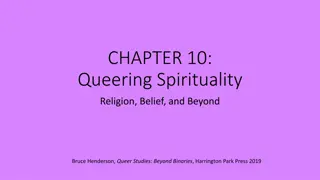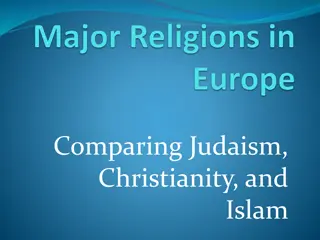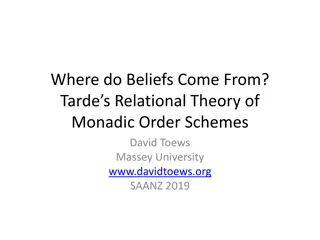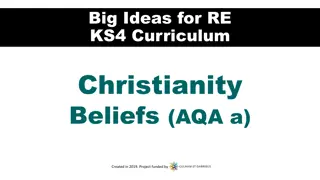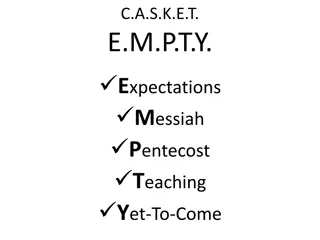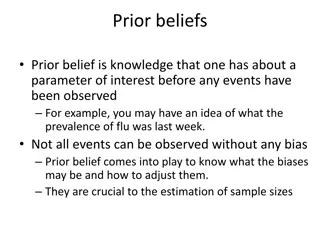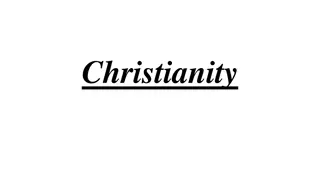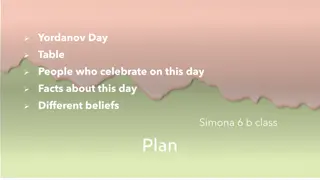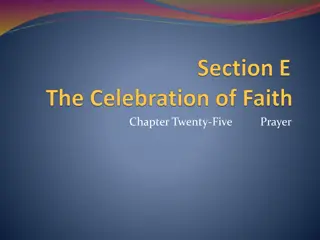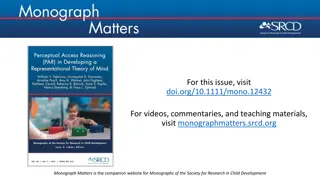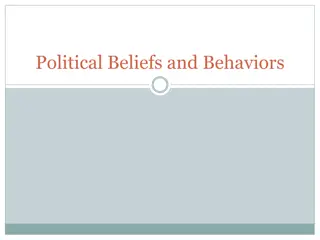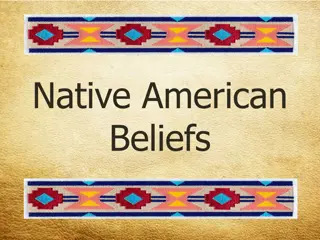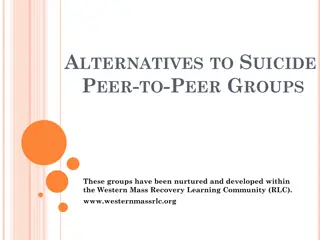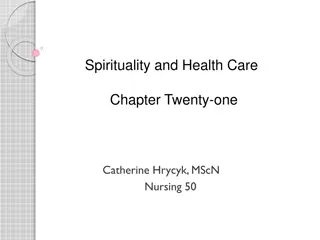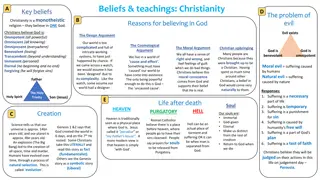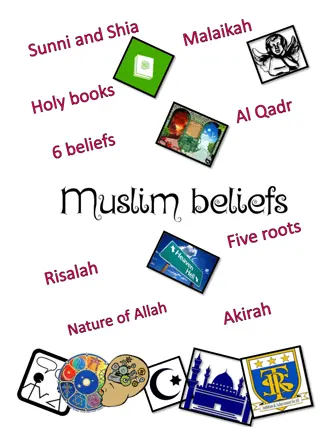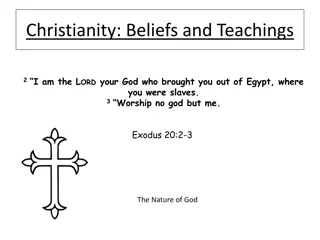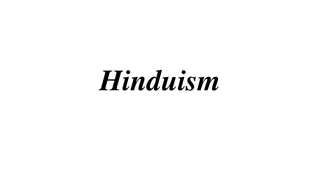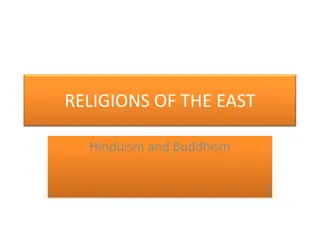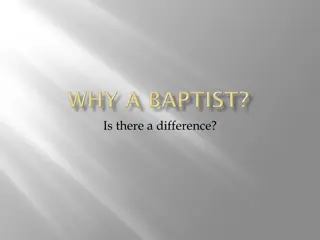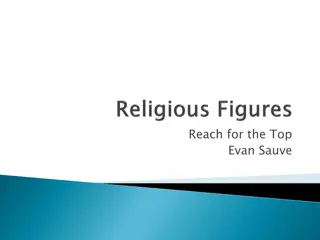Understanding Judaism: History, Beliefs, and Practices
Judaism, the oldest of the three Abrahamic faiths, originated over 3500 years ago in the Middle East. With around 13.1 million Jewish people worldwide, Judaism emphasizes a covenant relationship with God, observance of religious laws, and bringing holiness into daily life. Central to Judaism is the Torah, and Jewish life revolves around community, family, and ethical behavior. The faith defines who is Jewish, with a strong emphasis on individual and communal responsibilities to uphold religious practices.
Download Presentation

Please find below an Image/Link to download the presentation.
The content on the website is provided AS IS for your information and personal use only. It may not be sold, licensed, or shared on other websites without obtaining consent from the author. Download presentation by click this link. If you encounter any issues during the download, it is possible that the publisher has removed the file from their server.
E N D
Presentation Transcript
Judaism at a glance Judaism is the original of the three Abrahamic faiths, which also includes Christianity and Islam. According to information published by The Jewish People Policy Planning Institute, there were around 13.1 million Jewish people in the world in 2007, most residing in the United States and Israel. Judaism originated in the Middle East over 3500 years ago Jews trace their history back to Abraham. Jews believe that there is only one God with whom they have a covenant. In exchange for all the good that God has done for the Jewish people, Jewish people keep God s laws and try to bring holiness into every aspect of their lives. Judaism has a rich history of religious text, but the central and most important religious document is the Torah. Jewish traditional or oral law, the interpretation of the laws of the Torah, is called halakhah. Spiritual leaders are called Rabbis. Jews worship in Synagogues. 6 million Jews were murdered in the Holocaust in an attempt to wipe out Judaism. There are many people who identify themselves as Jewish without necessarily believing in, or observing, any Jewish law
Jewish faith and God The relationship with God Jews believe that there is a single God who not only created the universe, but with whom every Jew can have an individual and personal relationship. They believe that God continues to work in the world, affecting everything that people do. The Jewish relationship with God is a covenant relationship. In exchange for the many good deeds that God has done and continues to do for the Jewish People... The Jews keep God's laws The Jews seek to bring holiness into every aspect of their lives. Judaism is the faith of a Community Jews believe that God appointed the Jews to be His chosen people in order to set an example of holiness and ethical behavior to the world. Jewish life is very much the life of a community and there are many activities that Jews must do as a community. For example, the Jewish prayer book uses WE and OUR in prayers where some other faiths would use I and MINE. Jews also feel part of a global community with a close bond Jewish people all over the world. A lot of Jewish religious life is based around the home and family activities. Judaism is a family faith Judaism is very much a family faith and the ceremonies start early, when a Jewish boy baby is circumcised at eight days old, following the instructions that God gave to Abraham around 4,000 years ago. Many Jewish religious customs revolve around the home. One example is the Sabbath meal, when families join together to welcome in the special day.
Jewish faith in God (continued) Who is a Jew? Jews believe that a Jew is someone who is the child of a Jewish mother; although some groups also accept children of Jewish fathers as Jewish. A Jew traditionally can't lose the technical 'status' of being a Jew by adopting another faith, but they do lose the religious element of their Jewish identity. Someone who isn't born a Jew can convert to Judaism, but it is not easy to do so. Judaism means living the faith Almost everything a Jewish person does can become an act of worship. Because Jews have made a bargain with God to keep His laws, keeping that bargain and doing things in the way that pleases God is an act of worship. And Jews don't only seek to obey the letter of the law - the particular details of each of the Jewish laws - but the spirit of it, too. A religious Jew tries to bring holiness into everything they do, by doing it as an act that praises God, and honors everything God has done. For such a person the whole of their life becomes an act of worship. Being part of a community that follows particular customs and rules helps keep a group of people together, and it's noticeable that the Jewish groups that have been most successful at avoiding assimilation are those that obey the rules most strictly - sometimes called ultra-orthodox Jews. Note: Jews don't like and rarely use the word ultra-orthodox. A preferable adjective is haredi, and the plural noun is haredim. It's what you do that counts... Judaism is a faith of action and Jews believe people should be judged not so much by the intellectual content of their beliefs, but by the way they live their faith - by how much they contribute to the overall holiness of the world.
The Jewish view of God A summary of what Jews believe about God God exists There is only one God There are no other gods God can't be subdivided into different persons (unlike the Christian view of God) Jews should worship only the one God God is Transcendent: God is above and beyond all earthly things. God doesn't have a body Which means that God is neither female nor male. God created the universe without help God is omnipresent: God is everywhere, all the time. God is omnipotent: God can do anything at all. God is beyond time: God has always existed God will always exist. God is just, but God is also merciful God punishes the bad God rewards the good God is forgiving towards those who mess things up. God is personal and accessible. God is interested in each individual God listens to each individual God sometimes speaks to individuals, but in unexpected ways.
The Jewish view of God (continued) The Jews brought new ideas about God The Jewish idea of God is particularly important to the world because it was the Jews who developed two new ideas about God: There is only one God God chooses to behave in a way that is both just and fair. Before Judaism, people believed in many gods, and those gods behaved no better than human beings with supernatural powers. The Jews found themselves with a God who was ethical and good.
God in the Bible But how do Jews know this about God? They don't know it, they believe it, which is different. However, many religious people often talk about God in a way that sounds as if they know about God in the same way that they know what they had for breakfast. For instance, religious people often say they are quite certain about God - by which they mean that they have an inner certainty. And many people have experiences that they believe were times when they were in touch with God. The best evidence for what God is like comes from what the Bible says, and from particular individuals' experiences of God.
God and the Bible (continued) Quite early in his relationship with the Jews, God makes it clear that He will not let them encounter His real likeness in the way that they encounter each other. The result is that the Jews have work out what God is like from what He says and what He does. The story is in Exodus 33 and follows the story of the 10 commandments, and the Golden Calf. Moses has spent much time talking with God, and the two of them are clearly quite close... The LORD would speak to Moses face to face, as a man speaks with his friend. Exodus 33 But after getting the 10 commandments Moses wants to see God, so that he can know what He is really like. God says no... you cannot see my face, for no one may see me and live. Then the LORD said, There is a place near me where you may stand on a rock. When my glory passes by, I will put you in a cleft in the rock and cover you with my hand until I have passed by. Then I will remove my hand and you will see my back; but my face must not be seen. Exodus 33
Two sides of God Jews combine two different sounding ideas of God in their beliefs: God is an all-powerful being who is quite beyond human ability to understand or imagine. God is right here with us, caring about each individual as a parent does their child. A great deal of Jewish study deals with the creative power of two apparently incompatible ideas of God.
Converting to Judaism Converting to Judaism is not easy. It involves many lifestyle changes and about a year of studying. Becoming a Jew is not just a religious change: the convert not only accepts the Jewish faith, but becomes a member of the Jewish People and embraces Jewish culture and history.
Conversion and Jewish law Conversion to Judaism is a process governed by Jewish religious law. Conversions are overseen by a religious court, which must be convinced that the convert: is sincere is converting for the right reasons is converting of their own free will has a thorough knowledge of Jewish faith and practices will live an observant Jewish life There are also two ritual requirements: a male convert must undergo circumcision - if they are already circumcised, a single drop of blood is drawn as a symbolic circumcision the convert must undergo immersion in a Jewish ritual bath, a mikveh, with appropriate prayers
Judaism and conversion Judaism is not a missionary faith and so doesn't actively try to convert people (in many countries anti-Jewish laws prohibited this for centuries). Despite this, the modern Jewish community increasingly welcomes would- be converts. A person who converts to Judaism becomes a Jew in every sense of the word, and is just as Jewish as someone born into Judaism. There is a good precedent for this; Ruth, the great-great grandmother of King David, was a convert. Orthodox Jews usually don't accept the validity of conversions done by non- Orthodox institutions - because many Orthodox Jewish communities do not accept that non-Orthodox rabbis have valid rabbinical status.
Why convert? The most common reasons put forward are: because the person believes the faith and culture of the Jewish people is right for them in order to marry someone Jewish in order to bring up children with a Jewish identity But only the first of these should be accepted as the true reason for conversion - the convert must have an overpowering wish to join the Jewish people and share in their destiny, and be committed to loving God and following His wishes as expressed in the Torah. There is no other reason that can enable a person to truly enter the covenant between God and the Jewish people, and do it freely, without reservation, forever, and to the exclusion of all other faiths.
How to convert Different forms of Judaism have different conversion mechanisms, but this outline of what is involved covers the basics for all: discuss possible conversion with a rabbi study Jewish beliefs, history, rituals and practices learn some Hebrew get involved with Jewish community life believe in G-d and the divinity of the Torah agree to observe all 613 mitzvot (commandments) of the Torah agree to live a fully Jewish life circumcision (men only) immersion in a mikveh or ritual bath appear before a Bet Din (a religious court) and obtain their approval
Talking to the Rabbi Conversion to Judaism is not something to be done lightly. The rabbi will want to make sure that the person really wants to convert, and that they know what they're doing. Some rabbis used to test would-be converts by turning them away three times, in order to see how sincere and determined they are. This is unusual nowadays. If a person doesn't know any rabbis to discuss conversion with, they probably haven't got close enough to Judaism and Jewish life to be thinking of converting. They should start by talking to Jewish people, and attending some synagogue services. The rabbi asks the would-be convert a lot of questions - not just as a test of their sincerity, but in order to help the convert form a clear understanding of what they want to do: Why do you want to convert? What do you know about Judaism? Are you converting of your own free will? Have you discussed conversion with your family? Will you accept Judaism as your only religious faith and practice? Will you enter into the covenant between God and the Jewish people? Will you bring up your children as Jews? Are you willing to study in order to convert? Will you live as a member of the Jewish people?
Studying Would-be converts study Jewish beliefs, rituals, history, culture (including some Hebrew) and customs. They do this through courses, or by individual study with a rabbi. At the same time they will start going to services, joining in home practices (with members of their local community) and taking part in synagogue life.
Sabbath The Sabbath is commanded by God Every week religious Jews observe the Sabbath, the Jewish holy day, and keep its laws and customs. The Sabbath begins at nightfall on Friday and lasts until nightfall on Saturday. In practical terms the Sabbath starts a few minutes before sunset on Friday and runs until an hour after sunset on Saturday, so it lasts about 25 hours. God commanded the Jewish People to observe the Sabbath and keep it holy as the fourth of the Ten Commandments. The idea of a day of rest comes from the Bible story of the Creation: God rested from creating the universe on the seventh day of that first week, so Jews rest from work on the Sabbath. Jews often call the day Shabbat, which is Hebrew for Sabbath, and which comes from the Hebrew word for rest. A reminder of the Covenant The Sabbath is part of the deal between God and the Jewish People, so celebrating it is a reminder of the Covenant and an occasion to rejoice in God's kept promises. A gift from God Most Jewish people look forward to Shabbat all week. They see it as God's gift to His chosen people of a day when they take time out from everyday things to feel special. Shabbat is a time with no television, no rushing to the demands of the telephone or a busy work schedule. People don't think about work or other stressful things. It's an oasis of calm, a time of stillness in life.
Sabbath (continued) Sabbath greetings The traditional Sabbath greetings are Shabbat Shalom (Hebrew), or Gut Shabbos (Yiddish). A family time Shabbat is very much a time when families come together in the presence of God in their own home. Singles, or others with no family around may form a group to celebrate Shabbat together. Sabbath customs In order to avoid work and to ensure that the Sabbath is special, all chores like shopping, cleaning, and cooking for the Sabbath must be finished before sunset on Friday. People dress up for Shabbat and go to considerable trouble to ensure that everything is organized to obey the commandment to make the Sabbath a delight. Sabbath candles are lit at sunset on a Friday. The woman of the house usually performs this ritual. It is an integral part of Jewish custom and ceremony. The candles are placed in candlesticks. They mark the beginning of each Sabbath and represent the two commandments Zachor (to remember the Sabbath) and Shamor (to observe the Sabbath). After the candles are lit, Jewish families will drink wine. Sabbath wine is sweet and is usually drunk from a special goblet known as the Kiddush Cup. The drinking of wine on the Sabbath symbolizes joy and celebration.
Sabbath (continued) It is also traditional to eat challah, a soft rich eggy bread in the shape of a braid. Challah is eaten on the Sabbath and Jewish holidays except for the Passover when leavened bread is not permitted. Under Jewish law, every Jew must eat three meals on the Sabbath. One of the meals must include bread. Observant Jews will usually eat challah at the beginning of a Sabbath meal. Before the challah is eaten, the following prayer is recited: Baruch atah Adonai, Eloheinu Melech ha'olam, hamotzi lechem min ha'aretz. This means: Blessed are you, Lord our God, King of the universe, who brings forth bread from the earth. Other blessings, prayers, songs and readings may also be used. It is traditional, too, for parents to bless their children on Shabbat. Some of the family will have been to synagogue before the Sabbath meal, and it is likely that the whole family will go on Saturday.
Tefillin Tefillin (sometimes called phylacteries) are cubic black leather boxes with leather straps that Orthodox Jewish men wear on their head and their arm during weekday morning prayer. Observant Jews consider wearing tefillin to be a very great mitzvah (command). The boxes contain four hand-written texts from the Bible, in which believers are commanded to wear certain words on the hand and between the eyes. The texts are Exodus 13:1-10, 13:11-16; Deuteronomy 6:4-9, 11:12-21. The hand tefillin has all four texts written on a single parchment strip but the head tefillin has four separate compartments, with a single text in each. Jewish men start wearing tefillin just before their Bar Mitzvah. As with all ritual objects there are very specific rules about how to make tefillin, and how to wear them.
Tefillin (continued) Making tefillin Tefillin can only be made by specialists and often come with a certificate from a rabbi to prove that they've been made properly. The rules do not exist for their own sake, but to ensure that an article of such enormous religious significance is perfect in every way. The texts have to be written with halachically acceptable (acceptable according to Jewish law) ink on halachically acceptable parchment. There are precise rules for writing the texts and any error invalidates it. For example, the letters of the text must be written in order - if a mistake is found later, it can't be corrected as the replacement letter would have been written out of sequence. There are 3188 letters on the parchments, and it can take a scribe as long as 15 hours to write a complete set. The scribe is required to purify himself in the mikvah (ritual bath) before he starts work. The leather boxes and straps must be completely black. The boxes must be perfectly square seen from above. The stitches must also be perfectly square, and both thread and leather must be halachically acceptable. Wearing tefillin The arm tefillin is put on first, on the upper part of the weaker arm. A blessing is recited and the strap wrapped round the arm seven times. The head tefillin is loosely fastened on the head about one centimeter above a person's original hairline (the fact that a man's hair has receded is ignored). A blessing is recited and the strap is tightened with the knot at the back of the head. The strap of the hand tefillin is then wound three times round the middle finger while reciting Hosea 2:21-2.
Eruvs What is an Eruv? An eruv is an area within which observant Jews can carry or push objects on the Sabbath, (which lasts from sunset on Friday to sunset on Saturday), without violating a Jewish law that prohibits carrying anything except within the home. There are over 200 eruvs (or eruvim) in the world. An eruv must be 'completely enclosed'. The area is not enclosed by building a special wall round it - most of it is enclosed by existing natural boundaries like railway lines or walls. What matters is that the area is completely enclosed by boundaries that conform to Jewish law.
Eruvs (continued) What does an eruv allow people to do? An eruv mixes the boundary between the area within the home and the area outside it. The result is that within an eruv Orthodox Jews can follow the same rules on the Sabbath that they would in their homes. Jewish law says that Jews must not carry any item, no matter how small or for whatever purpose in a Reshus HaRabim (public domain - outside their home) on the Sabbath, even if they are allowed to carry them within their home. Pushing things is also forbidden - so families with small children (who would use prams and pushchairs) or the physically disabled (who would use wheelchairs) are effectively housebound. They can't even go to the synagogue to fulfil their religious duties on the Sabbath. But both carrying and pushing are allowed inside an eruv because it's regarded as within the home domain. So in an eruv Jews can: carry house keys (but not car or office keys) carry a handkerchief carry food or drink for use during the Sabbath carry prayer shawls carry books - normally a Jew can't even carry a prayer book on the Sabbath carry essential medicines - for example a diabetic Jew can now carry their insulin with them carry extra clothes such as a raincoat carry nappies carry reading glasses push a pram or wheelchair use a walking frame or crutches An eruv therefore makes it easier for Jews to follow the spirit of the Sabbath by making it enjoyable and fulfilling, without breaking the rules that keep it holy.
Eruvs (continued) What doesn't an eruv allow? An eruv doesn't permit Orthodox Jews to carry things that cannot be moved at all on the Sabbath, such as mobile phones or pens or wallets, or carry things for use after the Sabbath. Nor does an eruv permit Jews to do things that break the spirit of the Sabbath - such as going shopping or swimming, riding a bicycle or playing football in the park, or gardening.
Kippah/Yarmulke Clothing worn by Jews usually varies according to which denomination of Judaism they adhere to. Orthodox Jewish men always cover their heads by wearing a skullcap known in Hebrew as a kippah or in Yiddish as a yarmulke. Liberal or Reform Jews see the covering of the head as optional. Most Jews will cover their heads when praying, attending the synagogue or at a religious event or festival. Wearing a skullcap is seen as a sign of devoutness. Women also cover their heads by wearing a scarf or a hat. The most common reason (for covering the head) is a sign of respect and fear of God. It is also felt that this separates God and human, by wearing a hat you are recognizing that God is above all mankind. History There is disagreement over whether the covering of one's head is a Torah commandment. However there is some evidence in the Talmud (Jewish teachings) that some form of head covering is required.
The Old Testament The history of Judaism is inseparable from the history of Jews themselves. The early part of the story is told in the Hebrew Bible (Old Testament). It describes how God chose the Jews to be an example to the world, and how God and His chosen people worked out their relationship. It was a stormy relationship much of the time, and one of the fascinating things about Jewish history is to watch God changing and developing alongside His people.
The Bronze Age Jewish history begins during the Bronze age in the Middle East. The birth of the Jewish people and the start of Judaism is told in the first 5 books of the Bible. God chose Abraham to be the father of a people who would be special to God, and who would be an example of good behavior and holiness to the rest of the world. God guided the Jewish people through many troubles, and at the time of Moses he gave them a set of rules by which they should live, including the Ten Commandments.
The birth of Judaism This was the beginning of Judaism as a structured religion. The Jews, under God s guidance became a powerful people with kings such as Saul, David, and Solomon, who built the first great temple. From then on Jewish worship was focused on the Temple, as it contained the Ark of the Covenant, and was the only place where certain rites could be carried out.
The kingdom declines Around 920 BCE, the kingdom fell apart, and the Jewish people split into groups. This was the time of the prophets. Around 600 BCE the temple was destroyed, and the Jewish leadership was killed. Many Jews were sent into exile in Babylon. Although the Jews were soon allowed to return home, many stayed in exile, beginning the Jewish tradition of the Diaspora - living away from Israel.
Rebuilding a Jewish kingdom The Jews grew in strength throughout the next 300 years BCE, despite their lands being ruled by foreign powers. At the same time they became more able to practice their faith freely, led by scribes and teachers who explained and interpreted the Bible. In 175 BCE the King of Syria desecrated the temple and implemented a series of laws aiming to wipe out Judaism in favor of Zeus worship. There was a revolt (164 BCE) and the temple was restored. The revolt is celebrated in the Jewish festival of Hannukah.
Roman Times For a period the Jewish people governed themselves again and were at peace with the Roman Empire. But internal divisions weakened the Jewish kingdom and allowed the Romans to establish control in 63 BCE. In the years that followed, the Jewish people were taxed and oppressed by a series of "puppet" rulers who neglected the practice of Judaism. The priests or Sadducees were allied to the rulers and lost favor with the people, who turned increasingly to the Pharisees or Scribes. These were also known as Rabbis, meaning teachers.
1 CE - 70 CE: Rabbinic Judaism The Rabbis encouraged the Jewish people to observe ethical laws in all aspects of life, and observe a cycle of prayer and festivals in the home and at synagogues. This involved a major rethink of Jewish life. Although the Temple still stood, its unique place as the focus of Jewish prayer and practice was diminished. Many synagogues had been founded in Palestine and right around the Jewish Diaspora. Great teaching academies were founded in the first century BCE with scholars discussing and debating God's laws. The most well known of the early teachers were Hillel, and his contemporary Shammai.
70 - 200 CE: The destruction of the Temple This was a period of great change - political, religious, cultural and social turmoil abounded in Palestine. The Jewish academies flourished but many Jews could not bear being ruled over by the Romans. During the first 150 years CE the Jews twice rebelled against their Roman leaders, both rebellions were brutally put down, and were followed by stern restrictions on Jewish freedom. The first revolt, in 70 CE, led to the destruction of the Temple. This brought to an end the temple worship and is still perceived by traditional Jews as the biggest trauma in Jewish history. It is marked by the fast day of Tisha B'av (meaning the ninth day of the month of Av). A second revolt, in 132 CE, resulted in the death of hundreds of thousands of Jews, the enslaving of thousands of others, and the banning of Jews from Jerusalem
200 - 700 CE: The Mishna and Talmud Between 200 and 700 CE Judaism developed rapidly. Following the twin religious and political traumas, the academies moved to new centers both in Palestine and in the Diaspora. A sense of urgency had taken hold and it was considered vital to write down the teachings of the Rabbis so that Judaism could continue. Around 200 CE, scholars compiled the Mishna, the collection of teachings, sayings and interpretations of the early Rabbis. The academies continued their work and several generations of Rabbis followed. Their teachings were compiled in the Talmud which expands on the interpretations of the Mishna and established an all-encompassing guide to life. The Talmud exists in two forms. The first was finalized around the 3rd century CE in Palestine, and the second and superior version was completed during the 5th century CE in Babylon. During this period Jews were allowed to become Roman citizens, but later were forbidden to own Christian slaves or to marry Christians. In 439 CE the Romans banned synagogue building, and barred Jews from official jobs.
The Golden Age The Jews in Spain The years either side of 1000 CE were the golden age of the Jews in Spain. Co-existing happily with the country s Islamic rulers the Jews developed a flourishing study of Science, Hebrew literature and the Talmud. Despite an attempt to forcibly convert all Jews to Islam in 1086 CE, this golden age continued. At around this time the first Jews are recorded in Britain.
The Crusades The next Millennium began with the Crusades, military operations by Christian countries to capture the Holy Land. The armies of the first Crusade attacked Jewish communities on their way to Palestine, especially in Germany. When the Crusaders captured Jerusalem they slaughtered and enslaved thousands of Jews as well as Muslims. Following the example of the Romans earlier, they banned Jews from the city. In Britain, the Jewish population increased, benefiting from the protection of Henry I.
The bad times return The 1100s were a seriously bad period. Jews were driven from southern Spain by a Berber invasion. Serious anti-Jewish incidents began to occur in Europe: in France Jews were accused of ritually murdering a child in England Jews were murdered while trying to give gifts to the King at Richard I s coronation 150 Jews were massacred in York, England in 1215 the Catholic Church ordered Jews to live in segregated areas (ghettos) and to wear distinctive clothes.
Expulsions In England the Jews faced increasing restrictions during the Thirteenth Century, and in 1290 they were all expelled from England. Shortly afterwards the Jews were expelled from France. In 1478 the Jews in Spain suffered under the Spanish Inquisition, and in 1492 Jews were expelled from Spain altogether. The same thing happened in Portugal in 1497. 50 years later in Germany, Martin Luther (founder of Protestant Christianity) preached viciously against the Jews.
Scholarship, literature, and mysticism But it wasn t an entirely bad period for Judaism. Scholarship and literature flourished, with figures like Rambam, Luria, Levi ben Gershom, and Eleazar ben Judah. The Jewish form of mysticism, known as Kabbalah reached new heights with the publication in Spain of the Book of Splendor, which influenced Jewish Spirituality for centuries.
Jews return to Britain/come to America This was a period of Jewish expansion. Jews were allowed to return to England and their rights of citizenship steadily increased. In 1760 the main representative organization for British Jewry, The Board of Deputies of British Jews, was founded. Jews were first recorded in America in 1648.
Hassidism Poland and Central Europe saw the creation of a new Jewish movement of immense importance - Hassidism. It followed the example of the Baal Shem Tov (1700-1760) who said that you didn t have to be an ascetic to be holy; indeed he thought that the appropriate mood for worship was one of joy. The movement included large amounts of Kabbalic mysticism as well, and the way it made holiness in every day life both intelligible and enjoyable, helped it achieve great popularity among ordinary Jews. However it also led to divisions within Judaism, as many in the religious establishment were strongly against it. In Lithuania in 1772 Hassidism was excommunicated, and Hassidic Jews were banned from marrying or doing business with other Jews.
Persecution in Central Europe Towards the end of the 1700s Jews began to suffer persecution in central Europe, and in Russia they began to be restricted to living in a particular area of the country, called The Pale.
The birth of Reform Judaism In the 19th Century another new movement appeared in Judaism. This was Reform Judaism, which began in Germany and held that Jewish law and ritual should move with the times, and not be fixed. It introduced many changes to worship, and customs, and grew rapidly into a strong movement. It continues to flourish in Europe and the United States.
United Kingdom and United States In Britain and America this was the century of Jewish immigration, with great numbers of Jewish people arriving to escape the pogroms in Poland and Russia. The Jewish population of Britain increased by 250,000 in 30 years. It was at this time that the East End of London became a center of Jewish life in Britain. However in 1905 the United Kingdom passed a law that slowed immigration to a mere trickle.
The birth of Zionism The Zionist movement, whose aim was to create a Jewish state, was rooted in centuries of Jewish prayer and yearning to return to the land of Israel. Political Zionism began in the mid-19th Century and towards the end of the century it gained strength as many Jews began to feel that the only way they could live in safety would be to have a country of their own. In the Balfour Declaration of 1917, the British Government agreed that a national home for Jewish people should be established in Palestine. Following the First World War, the British governed the region in preparation for a permanent political arrangement. Over the next few years Jewish immigration increased and important institutions were founded such as the Israeli Chief Rabbinate, and the Hebrew University.
The Holocaust Jewish history of the 1930s and 1940s is dominated by the Holocaust, the implementation on an industrial scale of a plan to wipe the whole Jewish people from the face of Europe. The plan was carried out by the Nazi government of Germany and their allies. During the Holocaust 6 million Jewish people were murdered, 1 million of them children. The events of the Holocaust have shaped Jewish thinking, and the thinking of other people about Jewish issues ever since. War crimes trials of those involved in the Holocaust continue to this day. The tragedy affected much of the religious thinking of Jews, as they try to make sense of a God who could allow such a thing to happen to His chosen people.
The State of Israel The second defining Jewish event of the century was the achievement of the Zionist movement in the creation of the State of Israel in 1948. There had been strong and paramilitary opposition to British colonial rule for many years, and in 1947 the United Nations agreed a plan to partition the land between Jews and Arabs. In May 1948 the British Government withdrew their forces. Immediately, the surrounding Arab States invaded and the new Jewish State was forced to fight the first of several major wars. Notable among these were the 6-day war in 1967 and the Yom Kippur war in 1973. The first steps towards a permanent peace came when Israel signed a peace treaty with Egypt in 1979, and with Jordan in 1994. For most of its history Israel has had an uneasy relationship with the Arab states that surround it, and has been greatly sustained by the help and support of the United States, where the Jewish community is large and influential. The 21st century began with great political uncertainty over Israel and its relationship with the Palestinian people, and this continues.




